Digs & Discoveries
Off the Grid
By MARLEY BROWN
Thursday, October 06, 2022
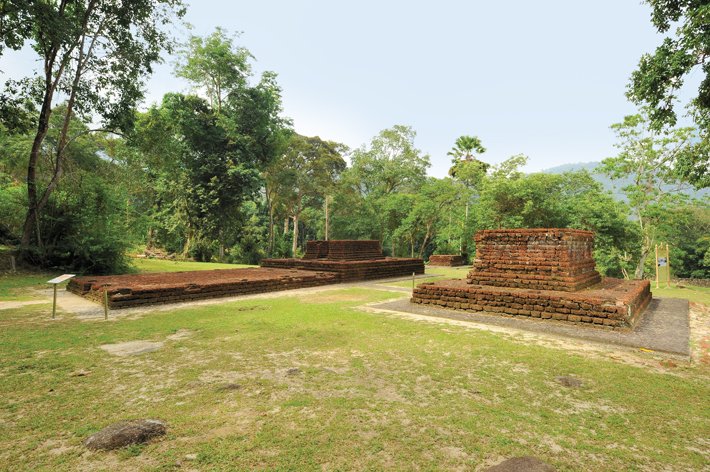
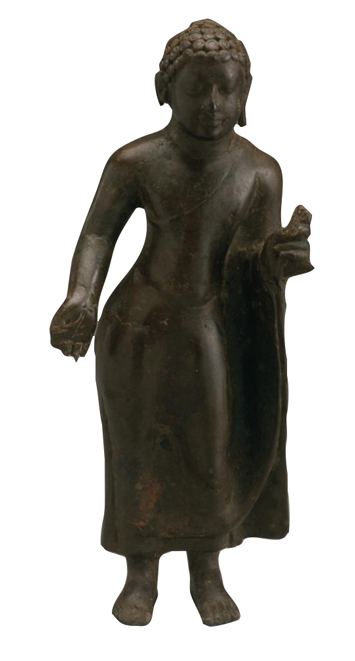 Malaysia’s Lembah Bujang, or Bujang Valley, is one of the earliest archaeologically documented crossroads for trade goods and religious ideas in Southeast Asia. The valley, which is located south of Mount Jerai in Kedah State near the coast of the Strait of Malacca, has been the subject of scholarly interest since the early nineteenth century. At that time, colonial officials with the East India Company uncovered evidence of a civilization bearing the influence of the Indian subcontinent, including traces of religious buildings and objects with motifs associated with Hinduism and Buddhism. Multiple excavations have since unearthed dozens of archaeological sites that suggest the region was home to a port and trade center where merchants from around Southeast Asia and beyond, including what is now the Arabian Peninsula, India, the Malay Archipelago, and China engaged in commerce and cultural exchange. Archaeologist John Miksic of the National University of Singapore says that, beginning in the seventh century A.D., the region may have become part of Srivijaya, a powerful empire based on the island of Sumatra to the south that wielded extensive influence over thousands of miles of coastline straddling the Strait of Malacca. “Most people assume that Srivijaya became the Bujang Valley’s overlord,” says Miksic. “But some others think Bujang entered into a trading alliance with them, something akin to the Hanseatic League of ports in the medieval period.” The Bujang Valley, Miksic says, was probably a Buddhist kingdom until around 1025, when the Hindu Chola Empire of south India conquered the region, as well as other ports on the Strait of Malacca.
Malaysia’s Lembah Bujang, or Bujang Valley, is one of the earliest archaeologically documented crossroads for trade goods and religious ideas in Southeast Asia. The valley, which is located south of Mount Jerai in Kedah State near the coast of the Strait of Malacca, has been the subject of scholarly interest since the early nineteenth century. At that time, colonial officials with the East India Company uncovered evidence of a civilization bearing the influence of the Indian subcontinent, including traces of religious buildings and objects with motifs associated with Hinduism and Buddhism. Multiple excavations have since unearthed dozens of archaeological sites that suggest the region was home to a port and trade center where merchants from around Southeast Asia and beyond, including what is now the Arabian Peninsula, India, the Malay Archipelago, and China engaged in commerce and cultural exchange. Archaeologist John Miksic of the National University of Singapore says that, beginning in the seventh century A.D., the region may have become part of Srivijaya, a powerful empire based on the island of Sumatra to the south that wielded extensive influence over thousands of miles of coastline straddling the Strait of Malacca. “Most people assume that Srivijaya became the Bujang Valley’s overlord,” says Miksic. “But some others think Bujang entered into a trading alliance with them, something akin to the Hanseatic League of ports in the medieval period.” The Bujang Valley, Miksic says, was probably a Buddhist kingdom until around 1025, when the Hindu Chola Empire of south India conquered the region, as well as other ports on the Strait of Malacca.
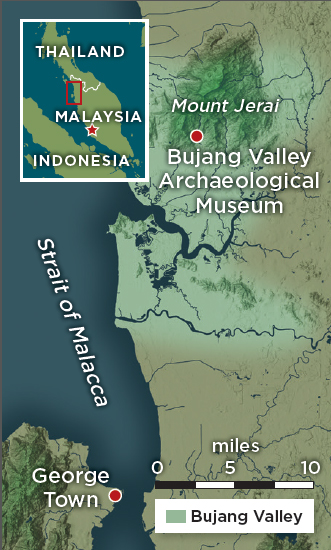
THE SITE
More than 30 temple ruin sites dot the roughly 90-square-mile Bujang Valley, clustered mainly along its waterways. Along the Batu River, archaeologists have discovered remnants of a possible jetty dating to as early as the second century A.D., as well as evidence of iron smelting operations. The Bujang Valley Archaeological Museum in the town of Merbok exhibits artifacts uncovered at sites around the Bujang Valley and offers guided tours of temples. The museum was constructed next to Site 8, also known as Candi Bukit Batu Pahat, a granite temple that was first excavated in the 1930s by English archaeologists H.G. and Dorothy Quaritch Wales. At the temple, which is believed to have been Hindu, the archaeologists discovered two nine-chambered stone reliquaries, as well as gold foil pressed with the image of Nandi, a bull figure associated with the god Shiva. Along the Bujang River, Dorothy Quaritch Wales excavated a Buddhist temple and a bronze Buddha statuette that likely date to the seventh century A.D.
WHILE YOU’RE THERE
The island of Penang, which lies off the west coast of the Malay Peninsula, and its capital city, George Town, continue the Bujang Valley’s tradition of multiculturalism. Take a tour of the center of George Town, which is filled with preserved colonial architecture, then hit the Chulia Street Night Market to sample cuisine from the city’s thriving Malay, Indian, Thai, and Chinese populations.

Side by Side
By MARLEY BROWN
Thursday, October 06, 2022
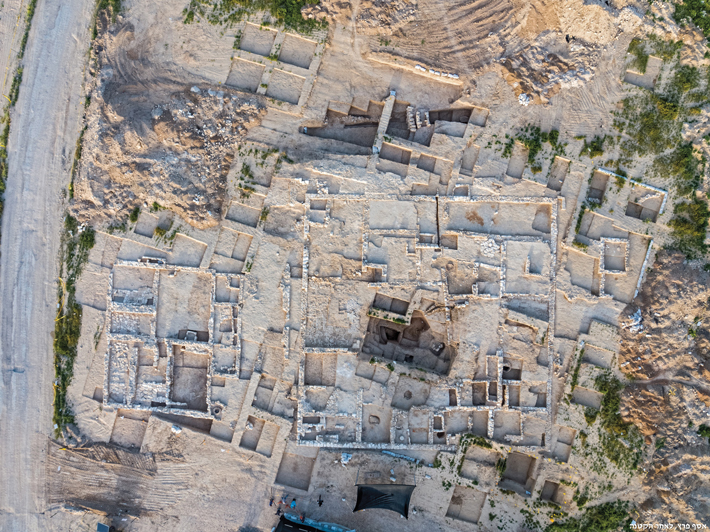 Construction in the town of Rahat in Israel’s Negev Desert has revealed evidence of the effects of Islam in the region between the seventh and ninth centuries A.D. Researchers discovered multiple buildings dating to the Umayyad (A.D. 661–750) and Abbasid (A.D. 750–1258) periods, including a mosque dating to the seventh or eighth century A.D. Roughly 400 yards away, the team discovered the ruins of a palatial Islamic-style building thought to have belonged to a local ruler, featuring walls decorated with frescoes and stone hallways arranged around a central courtyard. Beneath the courtyard, the team unearthed a 10-foot-deep, rock-hewn cistern system.
Construction in the town of Rahat in Israel’s Negev Desert has revealed evidence of the effects of Islam in the region between the seventh and ninth centuries A.D. Researchers discovered multiple buildings dating to the Umayyad (A.D. 661–750) and Abbasid (A.D. 750–1258) periods, including a mosque dating to the seventh or eighth century A.D. Roughly 400 yards away, the team discovered the ruins of a palatial Islamic-style building thought to have belonged to a local ruler, featuring walls decorated with frescoes and stone hallways arranged around a central courtyard. Beneath the courtyard, the team unearthed a 10-foot-deep, rock-hewn cistern system.
According to archaeologist Noe David Michael of the Israel Antiquities Authority, the building is similar to some Umayyad- and Abbasid-era structures found in Jordan, but is the first of its kind to have been uncovered in the Negev Desert. There appears to have been an extended period of coexistence between Christians and Muslims in the region. “Christian monasteries and churches were in use in some places until the ninth century,” says Michael. “It’s possible that the mosque we uncovered in Rahat was visited at the same time as Christian places of worship nearby.”
Cretan Antiquing
By BENJAMIN LEONARD
Thursday, October 06, 2022
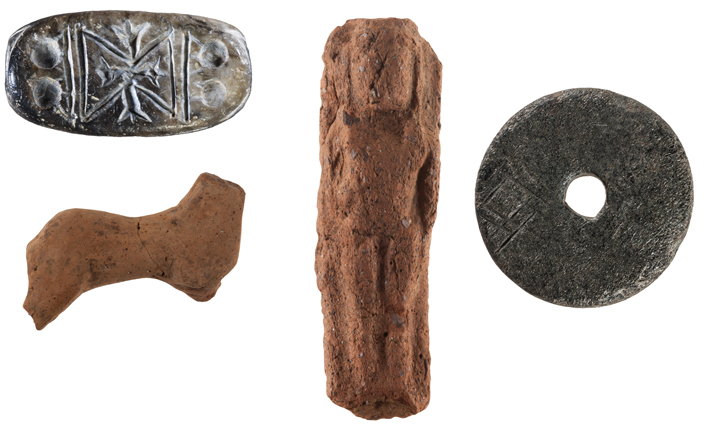 In the Anavlochos mountain range in eastern Crete, archaeologists have found hundreds of ancient terracotta fragments, mostly from female figurines, that were left as votive offerings in natural rock cavities in the seventh century B.C. Within one of these cavities was a more peculiar collection of well-worn objects, including a terracotta plaque of a woman and a steatite bead that likely both date to the eighth century B.C., as well as a seventh-century B.C. terracotta horse figurine. The cavity also contained a three-sided Minoan sealstone dating to between 1850 and 1700 B.C.—at least 1,000 years earlier than the other items. “The only thing these objects have in common is that they were already antiques when they were deposited in this cavity,” says archaeologist Florence Gaignerot-Driessen of the University of Cincinnati. “The fact that they were curated objects is clearly the reason why they were precious enough to be left as offerings.”
In the Anavlochos mountain range in eastern Crete, archaeologists have found hundreds of ancient terracotta fragments, mostly from female figurines, that were left as votive offerings in natural rock cavities in the seventh century B.C. Within one of these cavities was a more peculiar collection of well-worn objects, including a terracotta plaque of a woman and a steatite bead that likely both date to the eighth century B.C., as well as a seventh-century B.C. terracotta horse figurine. The cavity also contained a three-sided Minoan sealstone dating to between 1850 and 1700 B.C.—at least 1,000 years earlier than the other items. “The only thing these objects have in common is that they were already antiques when they were deposited in this cavity,” says archaeologist Florence Gaignerot-Driessen of the University of Cincinnati. “The fact that they were curated objects is clearly the reason why they were precious enough to be left as offerings.”
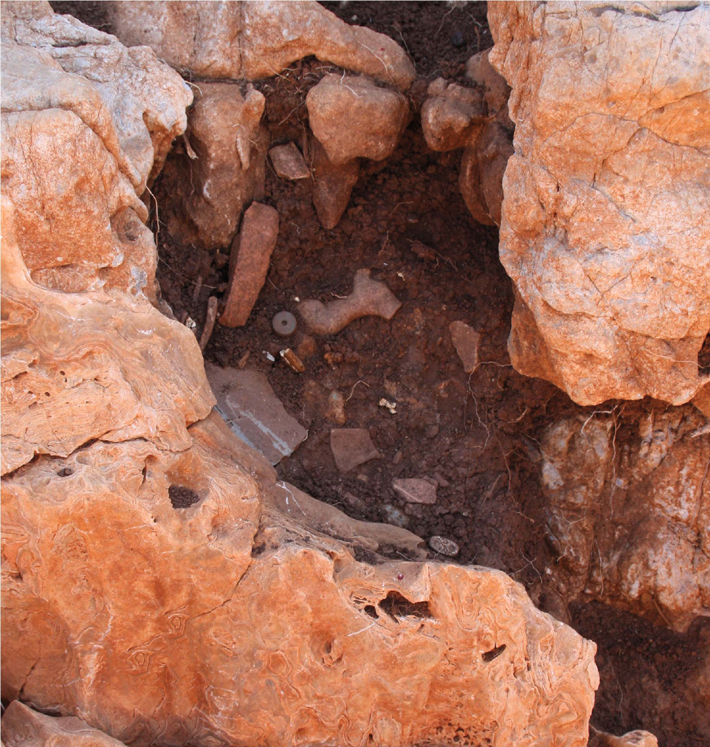 Homer’s Iliad and Odyssey mention similar collections of valuable curated objects, called keimelia, that were accumulated as gifts, heirlooms, and spoils of war. While studying the appearances of keimelia in these texts, Gaignerot-Driessen realized that they could have functioned as stand-ins for a missing person, either living or dead. She proposes that the four objects in the Anavlochos cavity might similarly have been intended to represent missing people by the individuals who placed them there. “This interpretation would change the way we perceive votive offerings,” Gaignerot-Driessen says. “They might represent the person offering the object, or someone they have in mind, and not the recipient, which would have been a deity.”
Homer’s Iliad and Odyssey mention similar collections of valuable curated objects, called keimelia, that were accumulated as gifts, heirlooms, and spoils of war. While studying the appearances of keimelia in these texts, Gaignerot-Driessen realized that they could have functioned as stand-ins for a missing person, either living or dead. She proposes that the four objects in the Anavlochos cavity might similarly have been intended to represent missing people by the individuals who placed them there. “This interpretation would change the way we perceive votive offerings,” Gaignerot-Driessen says. “They might represent the person offering the object, or someone they have in mind, and not the recipient, which would have been a deity.”
Royal Mountain Fortress
By DANIEL WEISS
Thursday, October 06, 2022
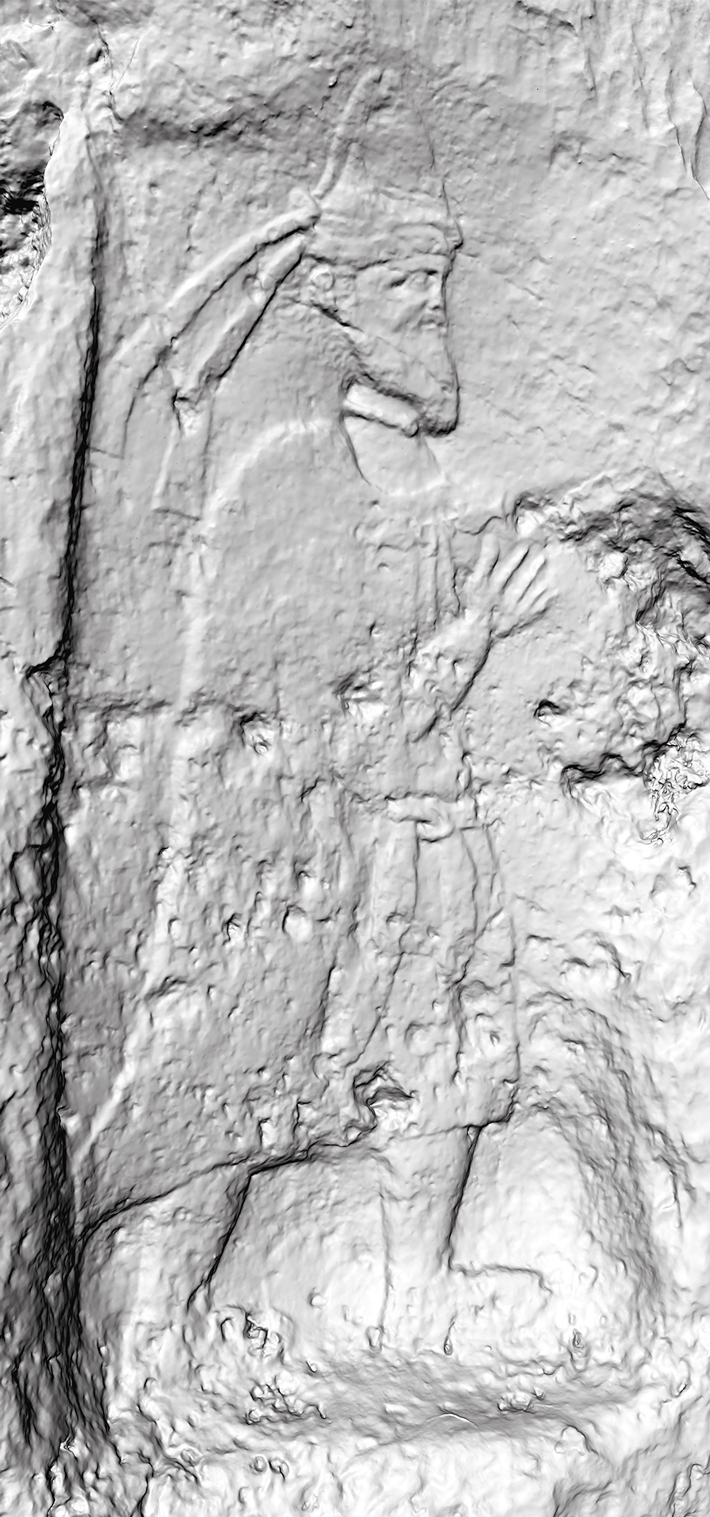 Archaeologists investigating a 2,000-year-old fortress in the Zagros Mountains of Iraqi Kurdistan believe it may be a lost city. The fortress of Rabana-Merquly stretches across some 2.5 miles of steep terrain overlooking a major tributary of the Lower Zab River. It was located on the southeastern frontier of the vassal kingdom of Adiabene, within the dominion of the Parthian Empire (247 B.C.–A.D. 224), which controlled territory from eastern Turkey to western Pakistan. According to Michael Brown, an archaeologist at Heidelberg University, the fortress was built at an intersection between the lowlands, where state authority was strong, and the highlands, which were home to restive pastoralist tribal groups. “It’s situated there to allow Adiabene to exert some influence over the highland domain,” Brown says.
Archaeologists investigating a 2,000-year-old fortress in the Zagros Mountains of Iraqi Kurdistan believe it may be a lost city. The fortress of Rabana-Merquly stretches across some 2.5 miles of steep terrain overlooking a major tributary of the Lower Zab River. It was located on the southeastern frontier of the vassal kingdom of Adiabene, within the dominion of the Parthian Empire (247 B.C.–A.D. 224), which controlled territory from eastern Turkey to western Pakistan. According to Michael Brown, an archaeologist at Heidelberg University, the fortress was built at an intersection between the lowlands, where state authority was strong, and the highlands, which were home to restive pastoralist tribal groups. “It’s situated there to allow Adiabene to exert some influence over the highland domain,” Brown says.
Rock reliefs carved into the cliff face next to each of the complex’s two gated entrances portray a nearly life-size individual who is identifiable as a Parthian-era ruler by his ceremonial headgear: a dome-shaped hat with a diadem attached to it. Brown says this figure must be a king of Adiabene based on the fortress’ location and the similarity of his attire to that of a statue in the city of Hatra, some 140 miles to the west, which is known to depict an Adiabenean king. The researchers suggest that the fortress was likely the royal city of Natounia, which is known from a handful of coins minted in the first half of the first century B.C., some of which say the city was located “on the Kapros,” the ancient name for the Lower Zab River. “Based on what we’ve got at the moment,” Brown says, “this is the best candidate because we’ve got these big pictures of kings next to our front doors.” If the fortress is indeed Natounia, then the reliefs likely depict its founder, Natounissar, or an immediate descendant. To see a photo of a section of the fortress' perimeter wall, click here.
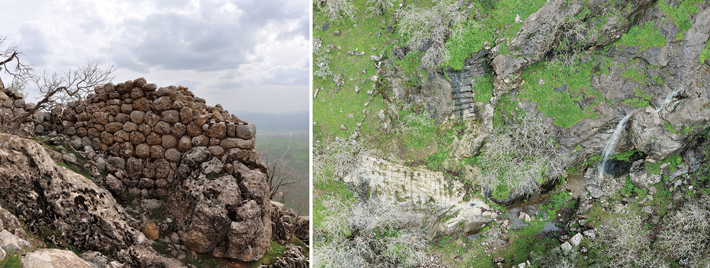
Miniature Gold Canvas
By HYUNG-EUN KIM
Thursday, October 06, 2022
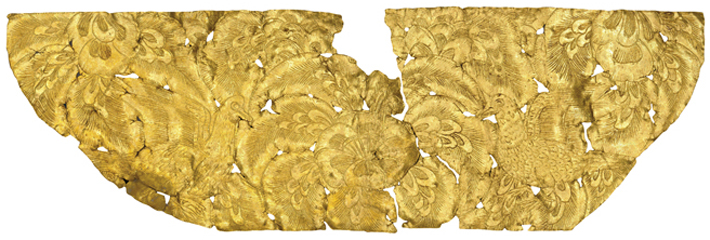
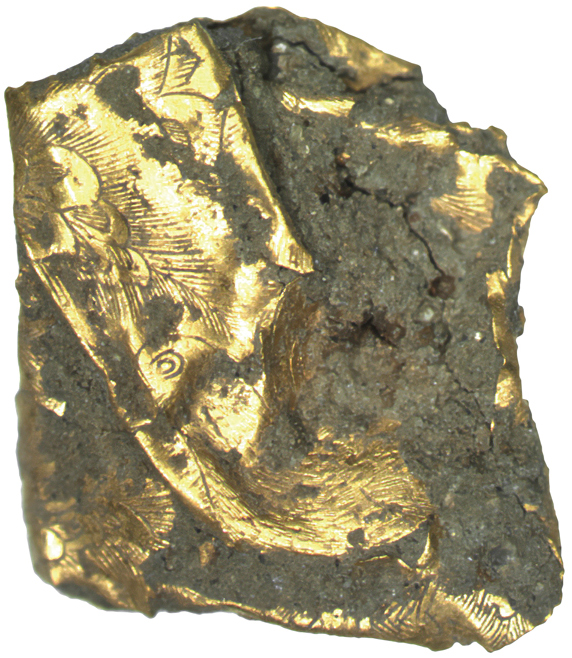 Two separate pieces of a delicate artifact about the size of a small paperclip that was first discovered at the site of a Silla Dynasty (57 B.C.–A.D. 935) royal palace in the South Korean city of Gyeongju in 2016 have now been conserved and reunited. The complete object was made of one one-hundredth of an ounce of 99.9 percent pure gold. It measures 1.4 inches by 0.5 inches and is thinner than a piece of paper. On this microscopic canvas, eighth-century A.D. Silla artisans carved lines thinner than a strand of hair to portray spectacularly detailed flowers seen from above to accentuate their fully bloomed petals. Amid the flowers is a pair of symmetrical birds facing each other.
Two separate pieces of a delicate artifact about the size of a small paperclip that was first discovered at the site of a Silla Dynasty (57 B.C.–A.D. 935) royal palace in the South Korean city of Gyeongju in 2016 have now been conserved and reunited. The complete object was made of one one-hundredth of an ounce of 99.9 percent pure gold. It measures 1.4 inches by 0.5 inches and is thinner than a piece of paper. On this microscopic canvas, eighth-century A.D. Silla artisans carved lines thinner than a strand of hair to portray spectacularly detailed flowers seen from above to accentuate their fully bloomed petals. Amid the flowers is a pair of symmetrical birds facing each other.
The two pieces of the artifact were found about 65 feet from each other, both crumpled into tiny balls. It was only when researchers unfolded and flattened and then examined them under a microscope that they realized the fragments belonged to a single object. The artifact’s purpose remains unknown. To see a detail of a finely engraved flower on the artifact, click here.
Advertisement
Advertisement
IN THIS ISSUE
Features
Priestess, Poet, Politician
Mexico's Butterfly Warriors
Magical Mystery Door
Letter from Australia
Digs & Discoveries
Assyrian Soft Power
Take a Seat
Before and After
Opening the Alabama Canal
Reduce, Reuse, Recyle
Neolithic Crystal Age
Colonial Connection
Vikings in Furs
Miniature Gold Canvas
Cretan Antiquing
Royal Mountain Fortress
Side by Side
Off the Grid
Around the World
The Nile’s lost branch, prehistoric Pacific tools, Louisiana’s 11,000-year-old mound, an Iranian fire temple, and the oldest octopus lures
Artifact
A roll of the dice
Advertisement

Recent Issues
-
 May/June 2024
May/June 2024
-
 March/April 2024
March/April 2024
-
 January/February 2024
January/February 2024
-
 November/December 2023
November/December 2023
-
 September/October 2023
September/October 2023
-
 July/August 2023
July/August 2023
-
 May/June 2023
May/June 2023
-
 March/April 2023
March/April 2023
-
 January/February 2023
January/February 2023
-
 November/December 2022
November/December 2022
-
 September/October 2022
September/October 2022
-
 July/August 2022
July/August 2022
-
 May/June 2022
May/June 2022
-
 March/April 2022
March/April 2022
-
 January/February 2022
January/February 2022
-
 November/December 2021
November/December 2021
-
 September/October 2021
September/October 2021
-
 July/August 2021
July/August 2021
-
 May/June 2021
May/June 2021
-
 March/April 2021
March/April 2021
-
 January/February 2021
January/February 2021
-
 November/December 2020
November/December 2020
-
 September/October 2020
September/October 2020
-
 July/August 2020
July/August 2020
-
 May/June 2020
May/June 2020
-
 March/April 2020
March/April 2020
-
 January/February 2020
January/February 2020
-
 November/December 2019
November/December 2019
-
 September/October 2019
September/October 2019
-
 July/August 2019
July/August 2019
-
 May/June 2019
May/June 2019
-
 March/April 2019
March/April 2019
-
 January/February 2019
January/February 2019
-
 November/December 2018
November/December 2018
-
 September/October 2018
September/October 2018
-
 July/August 2018
July/August 2018
-
 May/June 2018
May/June 2018
-
 March/April 2018
March/April 2018
-
 January/February 2018
January/February 2018
-
 November/December 2017
November/December 2017
-
 September/October 2017
September/October 2017
-
 July/August 2017
July/August 2017
-
 May/June 2017
May/June 2017
-
 March/April 2017
March/April 2017
-
 January/February 2017
January/February 2017
-
 November/December 2016
November/December 2016
-
 September/October 2016
September/October 2016
-
 July/August 2016
July/August 2016
-
 May/June 2016
May/June 2016
-
 March/April 2016
March/April 2016
-
 January/February 2016
January/February 2016
-
 November/December 2015
November/December 2015
-
 September/October 2015
September/October 2015
-
 July/August 2015
July/August 2015
-
 May/June 2015
May/June 2015
-
 March/April 2015
March/April 2015
-
 January/February 2015
January/February 2015
-
 November/December 2014
November/December 2014
-
 September/October 2014
September/October 2014
-
 July/August 2014
July/August 2014
-
 May/June 2014
May/June 2014
-
 March/April 2014
March/April 2014
-
 January/February 2014
January/February 2014
-
 November/December 2013
November/December 2013
-
 September/October 2013
September/October 2013
-
 July/August 2013
July/August 2013
-
 May/June 2013
May/June 2013
-
 March/April 2013
March/April 2013
-
 January/February 2013
January/February 2013
-
 November/December 2012
November/December 2012
-
 September/October 2012
September/October 2012
-
 July/August 2012
July/August 2012
-
 May/June 2012
May/June 2012
-
 March/April 2012
March/April 2012
-
 January/February 2012
January/February 2012
-
 November/December 2011
November/December 2011
-
 September/October 2011
September/October 2011
-
 July/August 2011
July/August 2011
-
 May/June 2011
May/June 2011
-
 March/April 2011
March/April 2011
-
 January/February 2011
January/February 2011
Advertisement






